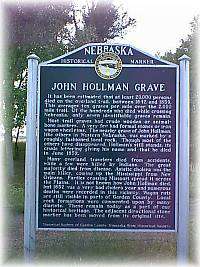The Hollman Grave Historical Marker
category : Historical Markers
 It has been estimated that at least 20,000 persons died on the overland trail between 1842 and 1859. This averages ten graves per miles over the 2,000 mile trail. Of the hundreds that died while crossing Nebraska, only seven identifiable graves remain.
It has been estimated that at least 20,000 persons died on the overland trail between 1842 and 1859. This averages ten graves per miles over the 2,000 mile trail. Of the hundreds that died while crossing Nebraska, only seven identifiable graves remain.Most trail graves has crude wooden or animal-bone markers. A very few had formal stones or iron wagon wheel rims. The nearby grave of John Hollman, like others in western Nebraska, was marked by a roughly fashioned local rock. Though most of the others have disappeared, Hollman's still stands, its crude lettering giving his name and that he died in June, 1852.
Many overland travelers died from accidents, while a few were killed by Indians. The great majority died from disease. Asiatic cholera was the main killer, coming up the Mississippi from New Orleans. Parties crossing Missouri spread it across the Plains. It is not known how John Hollman died, but 1852 was a very bad cholera year and numerous deaths were recorded in this vicinity. Wagon ruts are still visible in parts of Garden County. Local rock formations were commented upon by many diarists. These remain today as part of our historical heritage. The adjacent directional stone marker has been moved from its original site.
- Nebraska State Historical Society
Address: Highway 26 North
Come visit us in Oshkosh, Nebraska